|
History >
2005 > UK > Northern Ireland > Terrorism > IRA
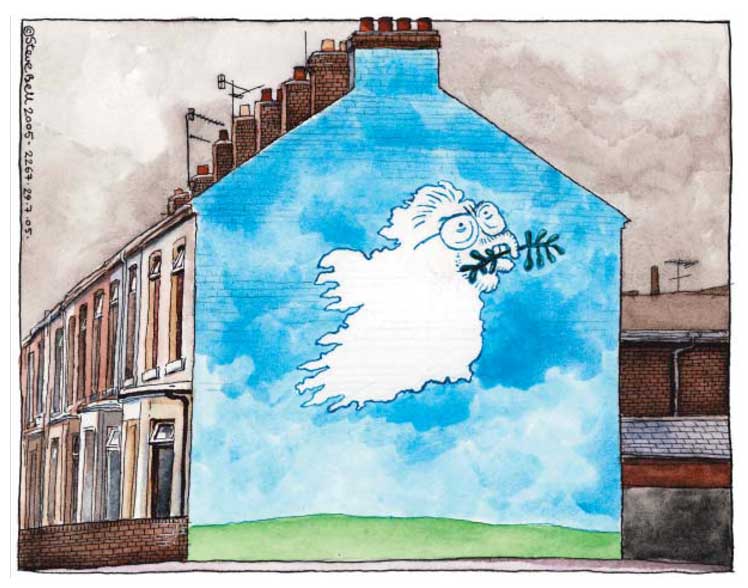
Steve Bell
cartoon
The Guardian p. 26
29.7.2005
'Better than before' is not good enough
The IRA's statement presents an opportunity we cannot squander
Peter Hain The Guardian
Friday July 29, 2005
http://www.guardian.co.uk/comment/story/0,3604,1538546,00.html
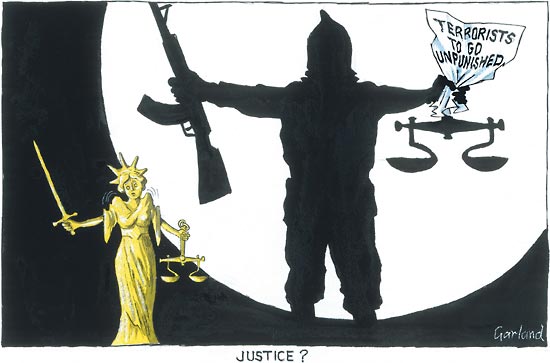
Garland
cartoon
The Daily Telegraph 24.11.2005
And what about justice for the victims of
Ulster?
DTel Opinion
24.11.2005
http://www.telegraph.co.uk/opinion/main.jhtml;jsessionid=
GIMHLTCXHT0U3QFIQMFCFF4AVCBQYIV0?view=HOME&grid=
P18&menuId=-1&menuItemId=-1&_requestid=117555
And what about justice
for the victims of
Ulster?
Filed: 24/11/2005
The Daily Telegraph
One of the many offensive, and more telling,
aspects of the plan to exempt fugitive IRA terrorists from punishment is the
language ministers use in an attempt to defend it. It is pure psychobabble.
The Prime Minister, in the Commons yesterday, spoke of the "pain and anguish" he
knew those bereaved by terrorists would feel. Mr Peter Hain, the Northern
Ireland Secretary, said the move was necessary for "bringing closure" to the
peace process. In plain terms, however, the idea that fugitives wanted for
sickening crimes - notably the Enniskillen Remembrance Day bombing of 1987 -
should be able to admit their guilt without facing a prison sentence is morally
and politically repugnant. It might be predicted that Unionist sentiment would
be revolted by it: but yesterday even Mark Durkan, the leader of the nationalist
SDLP, described the plan as a charter for victim-makers, not for victims. What
is additionally repellent, though, is the absence of any political need to
engage in yet another appeasement of criminals.
Comparisons have been made with the peace and reconciliation process in South
Africa. They are wrong. In the apartheid state, people were denied the right to
participate in democracy purely because of their race. Nelson Mandela took
violent action to obtain basic civil rights for his people. In Ulster, IRA
murderers had those rights like anyone else. They chose to murder because their
aims could not be achieved through the ballot box. They were not freedom
fighters: they were common criminals.
Those who have so far escaped justice must be made to pay for their crimes. The
so-called judicial process to which the Government is suggesting these people
submit themselves is discredited in advance. Serving judges in the Province are
refusing to have anything to do with it. It would, they know, destroy any notion
of the rule of law. Above all, there is no need for further concessions to the
IRA. They have lost their 35-year battle to overturn the will of the majority in
Ulster. After the attacks on America in 2001, their main international source of
political and financial support dried up. Former IRA men now pose uneasily as
politicians, or scrape a living as drug-runners. The last thing they deserve is
any further consideration from the British authorities, especially when it is
provided at the cost of any proper sense of justice.
The Government's general attitude to terrorism is now so twisted as to be
preposterous. Mr Blair cannot, with moral logic, seek to jail those who plot or
encourage such murder and mayhem as seen in London on July 7, but then let off
those who engaged in identical activities only a few years earlier. After the
abolition of the RUC and the destruction of the Ulster Unionist Party brought
about by its ruthless manipulation of David Trimble, the Government ought
already to have enough on its conscience where the people of Northern Ireland
are concerned. And to suggest they waive their right to justice is a betrayal of
more than just Ulster.
And
what about justice for the victims of Ulster?, DTel, Opinion, 24.11.2005,
http://www.telegraph.co.uk/opinion/main.jhtml;jsessionid=GIMHLTCXHT0U3QFIQMFCFF4AVCBQYIV0?view=HOME&grid=P18&menuId=-1&menuItemId=-1&_requestid=117555
4.15pm update
IRA arms decommissioned
Staff and agencies
Monday September 26, 2005
The Guardian Unlimited
The IRA's last remaining weapons have been put
beyond use, bringing an end to the organisation's military struggle against the
British in Northern Ireland, the decommissioning watchdog confirmed today.
"The decommissioning of the arms of the IRA is now an accomplished fact," said
John de Chastelain, the retired Canadian general who has been responsible for
overseeing the decommissioning process since 1997.
"This can be the end of the use of the gun in Irish politics," he added.
He presented a confidential report on his weapons inspections to the British and
Irish governments this morning following several months of decommissioning
actions in Northern Ireland and the Republic of Ireland.
He said they had been decommissioning since July but the bulk of the work had
been done in the past week, finishing on Saturday.
"The arms involved included the full range of ammunition, rifles, machine guns,
mortars, handguns, explosives, explosive substances and other arms," he said.
For the first time, IRA members present at the decommissioning admitted that all
their weapons had been put beyond use. "This time when we said to them, 'Is this
everything?' they said: 'Yes.'"
Irish Taoiseach Bertie Ahern said that the decommissioning was a "landmark
development".
"Today is a momentous day for the people of this island," he said. "Many
believed this day would never come. Many believe it should have happened a long
time ago. But it has now come.
"We cannot forget our sad and tragic past, but we must now look forward ... I
call on everyone to now seize the opportunity that is opening in front of us to
build a better Ireland."
The decommissioning was also welcomed by Tony Blair, who said in a statement:
"This is an important development in the peace process and one we have all been
waiting for, for a long time.
"Successive British governments have sought final and complete decommissioning
by the IRA for over 10 years. Failure to deliver it had become a major
impediment to moving forward the peace process.
"Today it is finally accomplished. And we have made an important step in the
transition from conflict to peace in Northern Ireland. "
A statement released by the IRA read: "The leadership of Oglaigh na h-Eireann
announced on July 28 that we had authorised our representative to engage with
the IICD to complete the process to verifiably put arms beyond use.
"The IRA leadership can now confirm that the process of putting our arms
verifiably beyond use has been completed."
Martin McGuinness, the Sinn Féin chief negotiator, said earlier that the
announcement would "bring the final chapter on the issue" of the IRA's weapons.
"Of course, this is about more than arms. It is about reviving the peace
process, it is about the future of Ireland," he said. "I believe that Ireland
stands on the cusp of a truly historic advance, and I hope that people across
the island will respond positively in the time ahead."
However, Unionists remain sceptical about the claims, putting back the likely
date of any further negotiations on power-sharing in Northern Ireland between
Sinn Féin and Ian Paisley's Democratic Unionist party.
At a press conference marking the decommissioning, the inspectors faced strong
criticism about whether their assurances could be relied upon.
Questions focused on the process of decommissioning, whereby IRA members brought
weapons to the inspectors from the secret arms dumps where they were being kept.
"We have handled every weapon that has been put beyond use, examining it,
counting them, weighing them, for a number of days," said Gen de Chastelain.
"We wouldn't give you that word if we had any doubts about it. We have nothing
to gain by telling you that this is done if it has not been done. We're not
prevaricating. We're telling you what we think."
Rev Paisley's DUP has already dismissed the decommissioning process as
inadequate and has demanded photographs, a detailed record and a
Paisley-approved Protestant clergyman to serve as an independent witness.
But the IRA refused to permit photos, and selected the two religious witnesses -
Rev Good, a former president of the Methodist Church in Ireland, and the Rev
Alex Reid, a Catholic priest - themselves.
"A witness who was appointed by the IRA is not going to have the same
credibility," the Democratic Unionist chairman, Nigel Dodds, said. "We have seen
stunts, hype and spin time out of number ... so it's going to be a lot harder,
more difficult, more challenging to get people to accept this as genuine."
However, the Rev Harold Good, the Methodist minister who acted as a Protestant
witness to the decommissioning, said that it was beyond doubt that the IRA's
weapons were now beyond use.
"We have spent many days, long days watching the painstaking way in which [the
commissioners] went about their task of decommissioning huge amounts of
explosives, arms and ammunition.
"The experience of seeing this in our own eyes on a minute by minute basis
provided us with evidence so clear that at the end of the process demonstrated
to us, and would have demonstrated to anyone standing with us, that beyond a
shadow of doubt the arms of the IRA have now been decommissioned," he said.
The IRA's arms dumps were mostly built up in the 80s thanks to shipments -
totalling more than 150 tonnes - from Libya.
Originally built up to allow the IRA to mount a guerrilla war against British
forces in Northern Ireland, they are scattered across the north and south of
Ireland and have been a key sticking point in talks between the Unionist and
Nationalist communities since the 1998 Good Friday agreement. Unionists have
refused to believe Sinn Féin was negotiating in good faith so long as the IRA
kept usable weaponry in reserve.
For its part, Sinn Féin, has had trouble convincing IRA lieutenants to give up
the symbols of its 36-year war while 10,000 British soldiers remained in the
province.
The locations of many of the arms dumps are thought to only be known to IRA
quartermasters, meaning the group's leaders needed to retain their loyalty to be
capable of decommissioning at all.
This month's steps follow the IRA's announcement in July that its military
campaign was at an end.
Sinn Féin will expect concessions from the British government as a result of the
decommissioning, including a halving of British troop numbers in Northern
Ireland and the right of IRA members on the run to return home without fear of
prosecution.
Decommissioning normally involves removing crucial components of the weapons to
make them unusable rather than their complete destruction.
Inspectors first gained access to one of the arms dumps in June 2000, and the
first decommissioning of weapons followed in October 2001.
Actions to put larger quantities of arms out of action came in April 2002 and
October 2003, but the October 2003 action underlined the difficulties inherent
in bringing all parties to the table.
IRA
arms decommissioned, G, 26.9.2005,
http://www.guardian.co.uk/Northern_Ireland/Story/0,2763,1578667,00.html
L'IRA, près d'un siècle de lutte
26.9.2005
Lemonde.fr
Voici les
principales dates
de l'histoire de l'Armée républicaine irlandaise (IRA) :
- 1913 : fondation des Volontaires irlandais,
organisation révolutionnaire ancêtre de l'IRA.
- 1921 : la République d'Irlande (Sud) devient
indépendante. Les six comtés d'Irlande du Nord restent au sein du Royaume-Uni.
- 1970 : l'IRA dite "provisoire" naît des
cendres de l'IRA officielle, qui a renoncé à la violence.
- 1981 : Bobby Sands, militant de l'IRA, et
neuf de ses compagnons se laissent mourir de faim en prison pour un statut de
prisonnier politique que le premier ministre britannique, Margaret Thatcher,
n'accordera jamais.
- 1983 : Gerry Adams élu président du Sinn
Fein (branche politique de l'IRA) et député de Belfast-Ouest.
- 1988-1994 : le dirigeant catholique et
nationaliste modéré John Hume ouvre le dialogue avec Gerry Adams, qui accepte de
s'engager sur la voie de la paix.
- 1er septembre 1994 : un cessez-le-feu de
l'IRA prend effet dans la liesse générale en Irlande du Nord.
- 9 février 1996 : l'IRA rompt sa trêve après
l'échec de pourparlers. Un attentat fait deux morts à Londres.
- 20 juillet 1997 : l'IRA déclare un nouveau
cessez-le-feu, et le Sinn Fein entre à nouveau dans les négociations de paix.
- 10 avril 1998 : accord historique du
Vendredi saint, conclu à Belfast entre Londres, Dublin et les partis protestants
et catholiques, dont le Sinn Fein. L'IRA annonce son soutien pour l'accord de
paix.
- 14 octobre 2002 : le gouvernement d'Irlande
du Nord, où catholiques et protestants partagent le pouvoir, est suspendu dans
le cadre d'allégations d'espionnage au profit de l'IRA par des membres du Sinn
Fein. Le processus de paix est paralysé.
- 9 décembre 2004 : échec des négociations
pour la relance du processus de paix.
- 20 décembre 2004 : cambriolage de la
Northern Bank de Belfast. Les autorités britanniques et irlandaises attribuent
le cambriolage à l'IRA.
- 31 janvier 2005 : le catholique Robert
McCartney meurt poignardé par des éléments incontrôlés de l'IRA.
- 3 février 2005 : l'IRA annonce la suspension
de son désarmement.
- 6 avril 2005 : au début de la campagne pour
les législatives du 5 mai, Gerry Adams annonce que l'IRA doit être mise
hors-circuit pour le succès du processus de paix et lance une consultation à cet
effet au sein du mouvement.
- 28 juillet 2005 : l'IRA annonce la fin de la
"lutte armée" et son intention de poursuivre son objectif de réunification de
l'Irlande par des voies démocratiques.
L'IRA,
près d'un siècle de lutte, Lemonde.fr / avec AFP, 26.9.2005,
http://www.lemonde.fr/web/article/0,1-0@2-3214,36-693174@51-688045,0.html
A brief history of the Troubles
The Guardian
Non daté - copié 26.9.2005
1688: William of Orange arrives
The British invite William of Orange, a
Protestant prince from the Netherlands, to rule England and Scotland. When he
arrives in Britain James II - the ruling, Catholic king - is deposed and flees
to Ireland. In 1690 William defeats James at the Battle of the Boyne, in
north-eastern Ireland, after which the Protestants who fought alongside William
are known as Orangemen. The battle is commemorated every July 12 with Orange
marches.
1916: The Easter Rising
Centuries of political and religious battles
over whether Northern Ireland should remain part of the UK culminate in the
Easter Rising on April 24 when of Irish rebels seize strategic buildings in
Dublin, notably the general post office. About 20,000 British soldiers enter the
city and fire on the rebels. The fighting lasts for five days and the rebels are
forced to surrender. Seventy are sentenced to death and 15 are executed,
fuelling support for Sinn Féin.
1919-1922: The war of independence, and
partition
Under the leadership of Michael Collins the
IRA uses violence to force Britain to negotiate. The Government of Ireland Act
is introduced, along with two parliaments, one in Dublin and one in Belfast. The
settlement establishes the Irish Free State, ruled by the Dublin parliament, but
leaves Northern Ireland part of the UK. Violence escalates as Catholics oppose
partition.
1922-26: Civil war and a split in Sinn Féin
Anti-partition forces, now known as the Free
State Army, take up arms against former IRA comrades. Fighting lasts for just
over a year and leaves Michael Collins dead. The provisional government puts
down the violence, and over 1,000 rebels are imprisoned without trial. The
leader of the Free State Army, Eamon de Valera, splits from republican
colleagues and founds the Fianna Fail party, which will come to dominate Irish
politics.
1939: Bombing campaign in England
The IRA launches a bombing campaign in
England. The Irish Free State, fearing for its independence, executes five IRA
leaders and interns many more republican volunteers.
1969: The Troubles begin in Northern Ireland
The Royal Ulster Constabulary attacks a
Catholic civil rights protest. Counter-demonstrations by Protestant loyalists -
so called for their "loyalty" to British rule - lead to escalating violence.
Frustrated by what they see as the passivity of the IRA's leadership, some
members form a new group, which they call the Provisional IRA.
1971-72: Internment and Bloody Sunday
Nearly 2,000 people are interned, or arrested
and held without trial, in a bid to prevent further attacks on British troops.
After internment is introduced, on August 9 1971, violent protests follow that
leave 17 dead. The move increases support for the IRA. On January 30 1972,
British soldiers shoot dead 13 men and injure 14 others, one of them fatally,
during a civil rights march in Derry against internment on what will become
known as Bloody Sunday. Thousands of people sign up to the IRA. Amid increasing
violence, the Belfast parliament is suspended and Northern Ireland is ruled
directly from London.
November-December 1974: The Birmingham
bombings
Twenty-one people are killed in November when
the IRA bombs two pubs in Birmingham city centre. The British government
responds by introducing the Prevention of Terrorism Act, which allows suspects
to be held without charge for up to seven days. A bomb also explodes at the
House of Commons in London, injuring 11 people. In December, the IRA calls a
ceasefire in the belief that the British are about to pull out of Northern
Ireland. Armed violence soon resumes.
The 1980s: Hunger strikes
Bobby Sands, the IRA leader held at the Maze
prison, dies after refusing food for 66 days. Nine others die of starvation
between May 12 and August 20 1981. Many people believe them to be martyrs to the
struggle for independence, and around 10,000 people attend Bobby Sands' funeral.
Support for the political wing of the IRA increases.
1993-94: Independence declared and another
ceasefire
Downing Street issues a declaration that the
people of Northern Ireland should be free to decide their own future. Sinn Fein
is offered a seat in parliament as long as IRA violence ends. The IRA declares a
complete cessation of military activities on August 31 1994.
July 1996: Riots over marches
Violent protests spread across Northern
Ireland when police block a key Orange Order parade near Portadown, an Orange
heartland. Police back down after four nights of Protestant riots across
Northern Ireland and the parade passes through Portadown's main Catholic
district, triggering three nights of Catholic riots and IRA gun attacks.
February 9 1996: Ceasefire collapses
The IRA bombs Canary Wharf in London after
John Major's government insists that decommissioning occurs as a precondition of
talks. Two people are killed and millions of pounds worth of damage is caused.
July 1997: Ceasefire restored
The IRA announces another ceasefire, allowing
Sinn Féin to join multi-party talks. Talks are hindered by paramilitary killings
on both sides, but continue until April 1998.
April 1998: The Good Friday agreement
The Good Friday agreement is reached on April
10 1998. It includes a devolved parliament and a role for the Republic of
Ireland in Northern Ireland affairs. Democratic Unionists oppose the deal as
giving too much power to Catholics.
July-August 1998: Violence and the Omagh
bombing
Britain having in January granted a
Catholic-Protestant commission new powers to restrict Protestant parades, police
and British troops in July block Portadown's Orangemen, who abandon a week-long
standoff only after three young Catholic brothers are killed in an arson attack.
On August 15 a car bomb kills 29 people in Omagh, in County Tyrone. The Real
IRA, a breakaway group, claims responsibility.
December 2004: Decommissioning deal unravels
The first act of decommissioning was announced
in October 2001 but the third, in October 2003,was rejected by unionists. In
December 2004 the deal starts to fall apart over photographs of IRA arms.
2005
February: The IRA withdraws its offer to
complete decommissioning. In April Gerry Adams appeals to the IRA to continue
the deal.
June 25: Orangemen postpone a parade on Belfast's Springfield Road because the
Parades Commission insists the Orangemen must avoid their usual route, near
Catholic homes, and go through an abandoned factory site instead.
July 12: Orangemen mount their largest annual parades across Northern Ireland.
They observe Parades Commission restrictions in several areas, including on
Springfield Road, but vow to stage their postponed June 25 parade eventually
without restrictions. Nationalist militants bombard police and British troops
with grenades and other weapons after a small Orange parade passes an IRA power
base in north Belfast. About 100 police and 10 civilians are wounded.
July 28: The IRA announces that it has formally abandoned its armed campaign.
Britain unveils a plan to cut the number of military bases and disband the
army's locally recruited Protestant divisions.
August 4: The Ulster Volunteer Force, one of
Northern Ireland's biggest outlawed Protestant groups, directs a mob attack on
police units in the hardline areas of Shankill and Crumlin Road, in Belfast,
after raids on homes of some of its members. A five-hour riot injures 40
officers and damages dozens of cars.
September 5: A UVF-directed mob on Shankill attacks police again following more
police raids. The next day the British and Irish governments receive a report
from international experts on violence being committed by UVF and other loyalist
gangs.
September 9: Orange leaders appeal to Protestants to stage sit-down street
protests as Saturday's restricted march proceeds.
September 10: Rioting erupts at several Orange protests at key roads and
intersections and on the main highway running through Belfast. Orangemen and
supporters scuffle in streets with police backed by British troops. Up to 50
police officers are wounded in two nights of rioting.
A
brief history of the Troubles, G,
http://www.guardian.co.uk/northernireland/page/0,12494,1569841,00.html
After 35 years of bombs and blood
a quiet voice ends the IRA's war
Friday July 29, 2005
Angelique Chrisafis, Ireland correspondent
The Guardian
The IRA yesterday declared that its war
against Britain was over. Even in the long debased hyperbole of historic moments
in the Northern Ireland peace process, this was a monumental announcement.
Its statement, unprecedented in its clarity, was delivered on a DVD by a
soft-spoken IRA volunteer called Seana Walsh, who at 50 is typical of the now
middle-aged rank and file of the organisation. He had spent 21 years in prison
and was one of the IRA "blanket men" during the hunger strike and dirty protests
in the Maze prison in the 1970s and 1980s.
Standing in front of an Irish tricolour, he announced that from 4pm a "formal
end to the armed campaign" had been ordered. All IRA units were ordered to "dump
arms". The IRA vowed to complete its long-running decommissioning process as
quickly as possible by "verifiably [putting] its arms beyond use".
The retired Canadian general John de Chastelain will oversee the final acts of
decommissioning, which could be completed within a month.
Although the statement did not address the thorny issue of criminality - which
has seen the IRA blamed for December's £26.5m Northern Bank robbery and the
murder of the Catholic father Robert McCartney - it makes it clear that
"volunteers must not engage in any other activities whatsoever".
Eleven years after the first ceasefire, the British and Irish governments hailed
it as the key that could unlock the final course of the peace process.
In a highly choreographed press conference in a south Dublin hotel, the Sinn
Féin leader, Gerry Adams, described the statement as a "truly momentous and
defining point in the search for a lasting peace with justice" and said the IRA
had made a unilateral "magnanimous, principled and generous" move.
But asked why the IRA did not specifically say it would end all criminal
activities, he shot back: "What part of 'any other activities whatsoever' do
people not understand?"
He made a dramatic appeal to the hardline Democratic Unionist leader, Ian
Paisley, who has refused to sit down at Stormont with Sinn Féin while the IRA
still exists. "Let's talk, let's engage, let's not let this opportunity be
wasted," he said.
Mr Adams's take on this historic moment was also clearly aimed at hearts and
minds in the Irish Republic.
With Sinn Féin's vote on the rise, it stands a real chance of soon having a
place in a coalition Dublin government if the IRA proves true to its word. Mr
Adams was clearly signalling that the ultimate prize was simultaneously holding
power across Ireland in a power-sharing assembly in the north and a coalition
government in the south.
Tony Blair said the IRA announcement was a "step of unparalleled magnitude ...
The statement is of a different order than anything before. It is what we have
striven for and worked for since the Good Friday agreement".
The taoiseach, Bertie Ahern, said it was "a great day for Ireland and Britain"
but in a joint statement with Mr Blair he cautioned that the IRA's words must be
"borne out by actions".
The Northern Ireland secretary, Peter Hain, writing in the Guardian, said: "In
this new environment it will be the responsibility of unionism to respond
positively.
"Provided that the actions have followed the words and the IRA is locked into a
democratic and peaceful path, then we will want early negotiations towards the
resumption of shared government through a resurrected Northern Ireland
assembly."
Already last night difficulties were rearing up.
Sinn Féin refuses to recognise the ceasefire watchdog, the Independent
Monitoring Commission, which will verify if the IRA has indeed ceased military
operations, punishment attacks and all forms of robbery and smuggling it is
alleged to be involved in.
After
35 years of bombs and blood a quiet voice ends the IRA's war, G, Friday July 29,
2005,
http://www.guardian.co.uk/Northern_Ireland/Story/0,2763,1538642,00.html
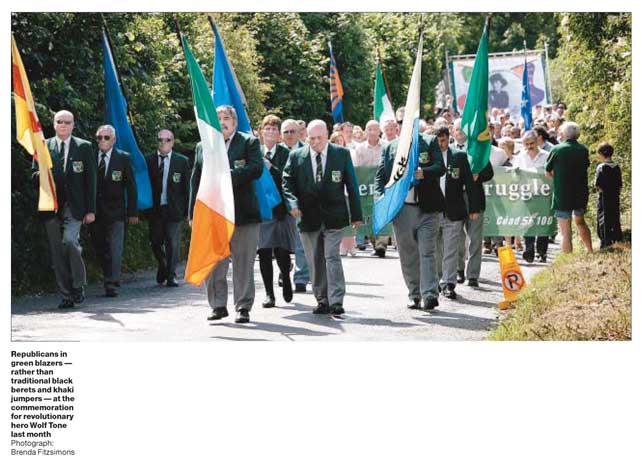
Men in green blazers - the future of the
IRA?
What next? One day it could become a benign veterans' group
Angelique Chrisafis, Ireland correspondent
The Guardian p. 3
29.7.2005
http://politics.guardian.co.uk/northernirelandassembly/story/0,9061,1538659,00.html
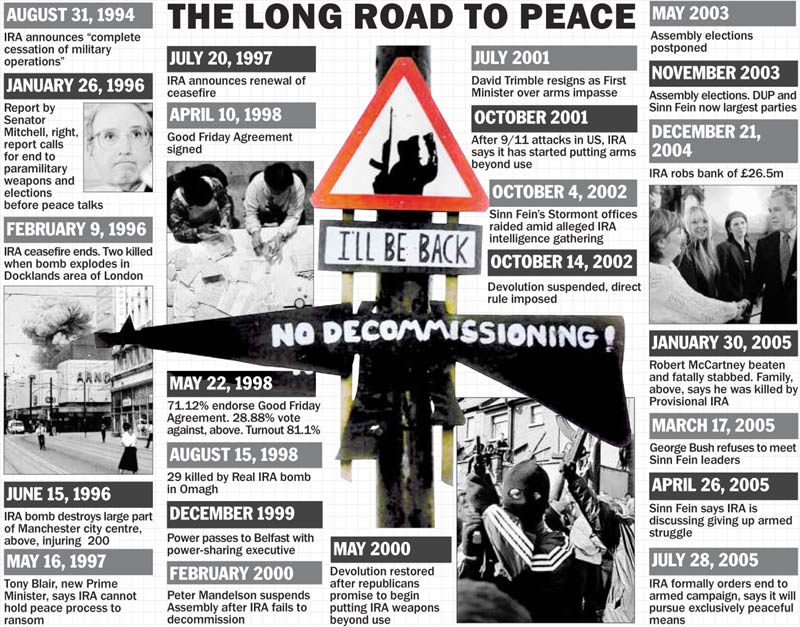
The Times
29.7.2005
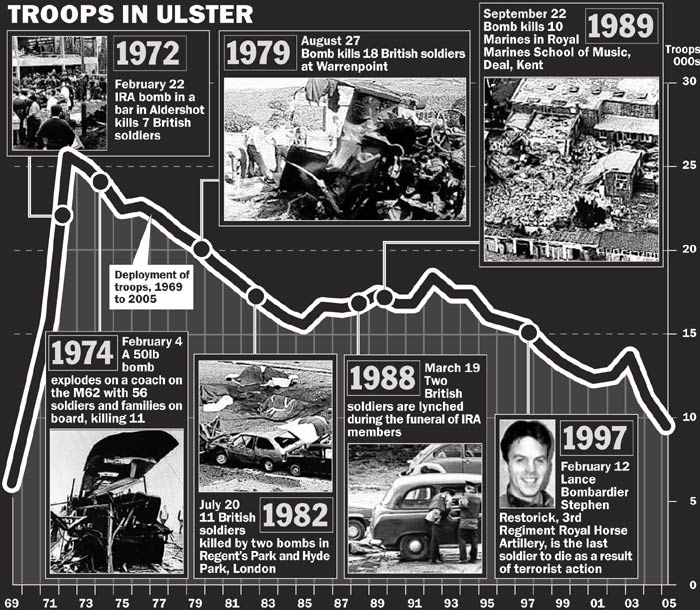
The Times
2.8.2005
August 02, 2005
Garrison to be halved as Army winds up longest operation
By Michael Evans, Defence Editor
Police and military chiefs
have agreed an
instant response to last week's IRA statement
THE Army’s longest-running military commitment,
codenamed Operation Banner,
will be wound up within the next 24 months after 38
years,
763 Service deaths and 6,100 injuries, all caused by terrorist action.
http://www.timesonline.co.uk/article/0,,2-1717292,00.html
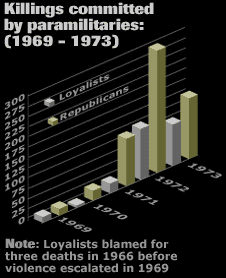
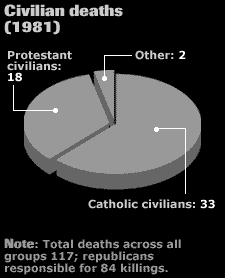
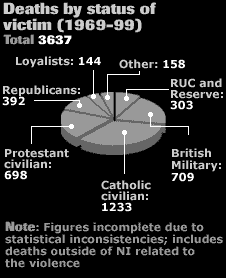
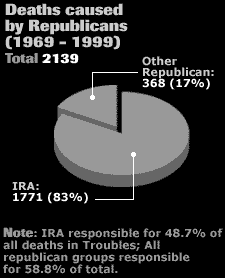
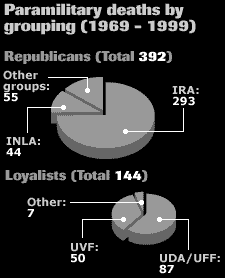
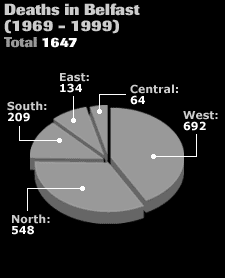
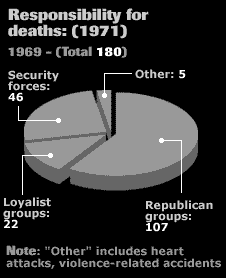
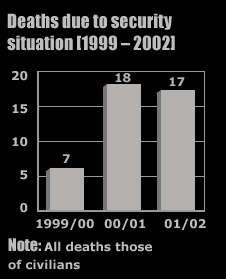
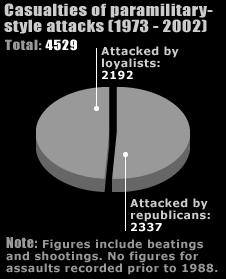
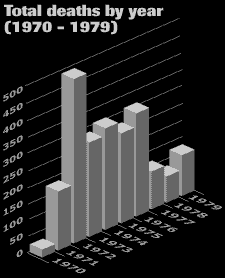
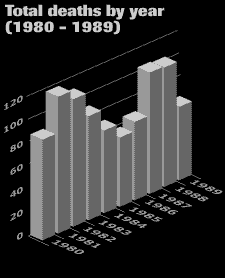
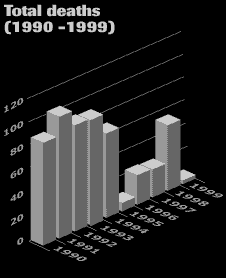
BBC News added 29.7.2005
|